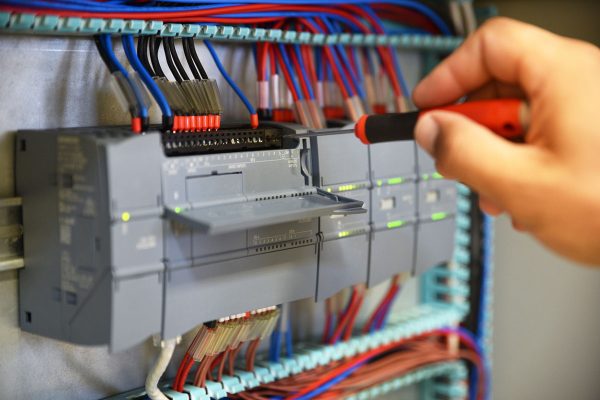Introduction: The Brains and Interface of Automation
In the world of industrial automation, two core technologies serve as the foundation of every modern control system: Programmable Logic Controllers (PLCs) and Human-Machine Interfaces (HMIs). Together, they manage the logic behind automated processes and enable operators to interact with machines in real time. While robotics and AI often dominate the headlines, it’s the PLC and HMI that keep critical systems running reliably on factory floors, assembly lines, and infrastructure projects worldwide.
What Is a PLC?
A Programmable Logic Controller is a ruggedized, industrial computer designed to execute control logic in real time. Originally developed to replace relay-based systems, modern PLCs are incredibly versatile, capable of handling digital and analog inputs/outputs, network communication, motion control, and safety protocols.
Typical functions include:
- Reading sensor data
- Making logic-based decisions
- Controlling actuators like motors and valves
- Communicating with other machines or systems
PLCs are typically programmed using ladder logic, function block diagrams, or structured text, depending on the application and standard (such as IEC 61131-3).
What Is an HMI?
A Human-Machine Interface is a user-friendly visual interface that allows humans to monitor, control, and interact with a machine or process. HMIs are typically touchscreens or panels installed on machines or control cabinets.
Key HMI functions include:
- Displaying real-time system data (temperatures, pressures, machine status)
- Logging alarms and historical data
- Allowing operators to start/stop processes, change setpoints, or reset faults
- Visualizing trends, charts, and diagnostics
In many ways, the HMI serves as the window into the world of the PLC.

How PLCs and HMIs Work Together
In an automated system, the PLC collects data from sensors and executes the programmed control logic. The HMI, connected via protocols like Modbus, EtherNet/IP, or Profinet, displays that information to the operator and allows for human intervention.
Example: In a bottling plant, a PLC might control the conveyor, filler, and capper sequences. The HMI shows machine status (e.g., “Running”, “Fault”), production counts, and allows the operator to adjust speed or clear alarms.
This interaction ensures smooth coordination between automated systems and human oversight.
The Impact of PLC and HMI Systems on Industry
PLCs and HMIs are foundational to nearly every industrial sector. Their influence goes far beyond simple automation—they enable flexible manufacturing, intelligent diagnostics, and data-driven decision-making.
Real-Time Control
PLCs are designed for deterministic performance, meaning they can execute tasks within guaranteed time frames. This is critical for applications like material handling, machine tools, and process control where even millisecond delays could cause failures.
Operational Efficiency
HMIs reduce downtime by giving operators real-time visibility into the health and performance of systems. Instead of relying on mechanical gauges or manual logs, teams can react to alarms immediately, diagnose issues faster, and get machines back online quickly.
Flexibility and Scalability
Modern PLCs can be easily reprogrammed to support new products, production schedules, or hardware configurations. This makes them ideal for flexible manufacturing environments where changeovers and custom runs are frequent. HMIs can also be updated to reflect new workflows or user needs.
Safety Integration
PLCs often include built-in safety functions or work alongside Safety PLCs to handle emergency stops, interlocks, and fail-safes. HMIs can visually display safety zones, access logs, and critical warnings to ensure compliance and protect personnel.
Data Logging and Analysis
With the rise of Industry 4.0, PLCs and HMIs are increasingly connected to higher-level systems like SCADA, MES, and cloud platforms. This enables long-term data logging, performance analytics, and predictive maintenance strategies based on trends and anomalies.
Reduced Human Error
By automating complex logic and visualizing critical data, PLCs and HMIs reduce the dependence on manual operations and checklists. This minimizes errors, especially in repetitive or high-speed processes.
Key Technologies and Protocols
The functionality of PLCs and HMIs continues to evolve alongside networking and communication advancements.
Some commonly used technologies include:
- Ethernet/IP and Profinet: For real-time device communication
- OPC UA: For standardized data sharing across platforms
- SCADA integration: For higher-level process control and monitoring
- Remote access tools: For troubleshooting HMIs and PLCs via VPN or cloud dashboards
These tools make PLC-HMI systems more connected, responsive, and scalable.
Real-World Applications
- Water Treatment Plants: PLCs control pumps and chemical dosing, HMIs monitor tank levels and pH
- Packaging Lines: PLCs sequence machinery while HMIs display product counts and changeover options
- Building Management Systems: PLCs manage HVAC and lighting, with HMIs accessible via touchscreen kiosks
- Food Processing: HMIs guide sanitation cycles and allow recipe changes; PLCs manage flow, pressure, and timing
These examples show how universally applicable and critical these systems are, across scales and sectors.
The Future of PLC and HMI Systems
The future lies in even tighter integration between hardware, software, and human interaction. As machine learning and AI enter the picture, PLCs may start making recommendations based on learned behaviour. HMIs will become more intuitive, multilingual, and tailored to individual operator preferences.
Expect:
- Voice-controlled HMIs
- Smart alarms based on context, not thresholds
- PLCs with built-in AI modules
- Seamless handoff between local and cloud-based control
These trends signal a future where automation is more intelligent, adaptive, and collaborative than ever before.
PLCs and HMIs are far more than basic controllers and screens—they are the nerve center and dashboard of the modern industrial world. As industries move toward smarter, more connected factories, these systems remain vital for control, insight, and optimization. Understanding how they function—and where they’re headed—is key to designing resilient, efficient, and forward-looking operations.
